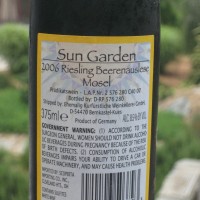Variety: Riesling
Country: Germany
Region: Mosel (formerly called Mosel-Saar-Ruwer until 2007))
Appellation: Bernkastel-Kues
Producer: Sun Garden
Prädikatswein: Beerenauslese
German wines can, initially, be a little intimidating. The German wine labels have a lot of information and descriptive words, but are confusing because they are, well, in German. Once you learn some of the basic German wine vocabulary, the labels become extremely helpful and very descriptive about the juice inside. I actually think that German wine labels tell more about the wine than any other country’s labeling system.
There are levels of quality distinctions that exist in the German wine industry. The highest classification of these is Prädikatswein, recently renamed from Qualitätswein mit Prädikat (QmP). Prädikatswein must be produced from an allowed grape variety in one of the 39 subregions (Bereich) from one of the 13 wine-growing regions. Wines of this distinction display additional descriptive information called a Prädikat. The Prädikat relates to the must weight (sugar content) and ranges from Kabinett, or dry, to Trockenbeerenauslese, intensely sweet. The level required is dependent on grape variety and wine-growing region and is defined in terms of the Oechsle scale.
The rules for these wines are very strict and forbid chaptalization, the addition of sugars to the wine. For this reason, the high sugar must come from “acceptable” and natural means. Increasing grape sugars can be done in a few ways. One way, that we just mentioned, is chaptalization, or adding sugar. Sugars will also be higher in wines that prematurely stop the fermentation process, where all the grape sugars are not fully consumed by the yeast. Also, grapes that are harvested “late” have a naturally higher sugar content, especially if they are allowed to freeze. The Beerenauslese and Trockenbeerenauslese wines often use Noble Rot, Botrytis cinerea, to concentrate the grape sugars. This mold attacks healthy grapes, weakening the skins and speeds up the evaporation of water from the grape flesh, causing them to shrivel. The resulting wine not only has a high sugar content but also boasts unique flavors created from the Botrytis.
The Sun Garden label offers varietal wines from many well known German regions such as Pfalz, Rheinhessen and Nahe, but in our case, it takes us to Mosel. Located Along the river Moselle (Mosel) and its tributaries, the rivers Saar and Ruwer, the wine area was previously known as Mosel-Saar-Ruwer until August 2007. The region is dominated by Riesling grapes and slate soils with some of the best wines grown in dramatic-looking steep vineyards directly overlooking the rivers. Because of the steep geography, these vineyards are considered some of the most labor intensive in the world. Sun Garden has its Mosel region presence around the town of Bernkastel-Kues and focuses on two varietals, Riesling and Pinot Noir. They buy grapes from a local cooperative, whose members operate vineyards on those steep slopes overlooking the river valley.
Sun Garden produces a variety of Prädikatswein with a range of must levels. This particular wine, the 2006 Mosel Riesling, is a Beerenauslese. The term Beerenauslese literally means “select berry harvest” and is made from individually selected overripe grapes often affected by the Noble Rot. This high must weight and residual sugar is readily apparent in the wine, having a full-bodied and viscous mouth feel. The nuances of cooked apricot and raw honeycomb are seductive. As with many German wines, the sweetness is extremely well balanced with the wine’s natural acidity preventing that cloying sweet syrup-like quality.
Although I highly recommend this wine, I feel it needs a properly paired dessert to reach its full potential. Remember, when pairing wines with desserts, the wine should be slightly sweeter or the dessert will make the wine taste flat. We paired this with a trifle containing vanilla cake, blueberries, and custard, which worked well.
I really like this wine and rate it as a B+. With the cost of a half bottle (375ml) at under $30, I give it an A- for the price. This is a great dessert wine at a great price. Try this with your summer desserts containing fresh fruit. Above all, have fun with wine!


 Masters of Wine
Masters of Wine Wine and Spirits Education Trust
Wine and Spirits Education Trust